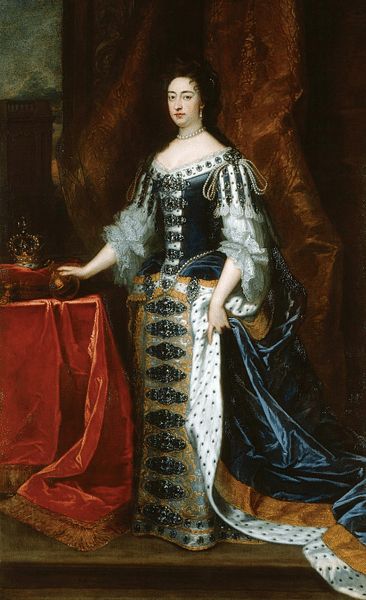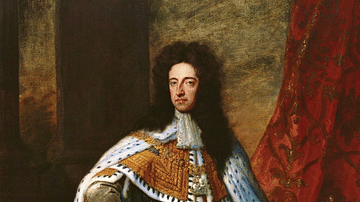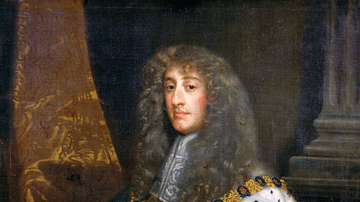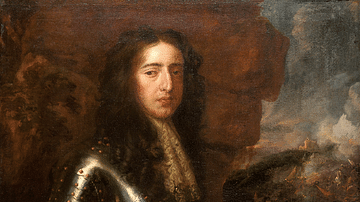
Mary II of England (r. 1689-1694) ruled jointly with her husband William III of England (r. 1689-1702) until her death from smallpox. While William suffered a xenophobic reaction to his rule, Mary represented the continuity of the Royal House of Stuart and was much more popular with the people than her Dutch husband.
Early Life & Family
Mary was born on 30 April 1662 at St. James' Palace, London. Mary's father was James II of England (r. 1685-1688) of the Royal House of Stuart. Mary's mother was Anne Hyde, the daughter of the Earl of Clarendon and the first wife of James. Anne died of illness in March 1671. King James inherited the throne from his brother Charles II of England (r. 1660-1685) who died in February 1685 without any legitimate children. This succession was not straightforward since while Charles had been alive James had converted to Catholicism (in 1668). Ever since the English Reformation and events like the 1605 Gunpowder Plot to blow up the king and Parliament, Catholics had been looked upon with suspicion in England. In 1679, a group of 'Whig' politicians managed to sway Parliament into excluding James from the succession because of his faith, but his brother Charles had him reinstated. One of the conditions of his reinstatement was that James guarantee both Mary and her younger sister Anne (b. 1665) be brought up as Protestants. Mary cast a graceful figure with her long dark hair, brown eyes, and a smooth, white complexion. Mary was a little taller than average and danced well.
Encouraged by Charles II to ensure the continued goodwill of his Protestant subjects, Mary married her cousin William, Prince of Orange (b. 1650) on 4 November 1677. William, a Dutch Protestant, was not a great catch in terms of appearance; he was short (5 inches / 12 cm shorter than Mary), hunched, had a hooked nose and black teeth, and his character was no improvement being taciturn and humourless. Mary wept for a day and a half on hearing news of her arranged marriage. The couple did eventually build a strong bond, but although Mary wrote affectionate letters to her husband throughout their marriage, William kept mistresses, and rumours abounded that his taste ran to young men, too.
When her father took the throne, Mary became his heir and remained so as James' second wife Mary of Modena proved unlucky at childbirth and all the couple's children died young. Then the situation changed dramatically on 10 June 1688. At last, James and Mary had a son, James Francis Edward. He would surely be brought up a Catholic like both his parents, and this was of great concern to many in Parliament. There were rumours James planned to take England back to being a Catholic country, and even if there was not much concrete evidence of this intention, the king certainly fuelled suspicion by appointing Catholics in many key positions of power. James was also too authoritarian for some politicians' taste, ignoring laws, misapplying others, and even dismissing Parliament in November 1685. While many had been prepared to wait for the king to die naturally and be replaced by Protestant Mary, James Francis Edward's birth changed everything. A group of seven prominent Protestants now looked abroad for a solution.
The Glorious Revolution
William of Orange was an obvious choice to replace James II. He was Protestant, a grandson of Charles I of England, and, of course, was married to Mary. Further, despite the recent naval wars, Britain and the Netherlands were natural allies against Catholic France, which was then dominant on the Continent. Perhaps motivated more by the military possibilities than anything else, William accepted the invitation from English Protestants and launched an invasion. The Dutchman and an army of up to 21,000 men landed in Devon, England on 5 November 1688. Deserted by some of his closest allies and not sure what to do, James tried to flee but was captured. William then allowed his father-in-law to leave England unmolested and join his family in France. The throne was now empty, and Parliament recorded the abdication as occurring on 23 December 1688 when James left English shores.
A Constitutionnel Monarchy
The next steps were rather more complex. The 'Whigs' in the House of Commons (Parliament's lower house) wanted a joint rule between William and Mary. Mary's own view was that William should rule as regent for her father, she had no ambition to rule alone. The 'Tories' in the House of Lords (the upper house) wanted Mary to rule alone and so preserve the natural line of succession. William would not settle for a minor role, though, and threatened to withdraw leaving chaos. Accordingly, on 13 February 1689, Parliament decreed that the pair rule jointly, even if in practice it was William who exercised the sovereign powers. Mary did formally rule, though, in those periods when William was absent from the kingdom. William III of England (also William II of Scotland) and Mary II of England were crowned in Westminster Abbey on 11 April. Their joint reign is often simply called 'the reign of William and Mary', and newly-minted coins showed the two monarchs together. It had been a Glorious Revolution in the sense that there had been very little violence and the kingdom's traditions of governance had been preserved.
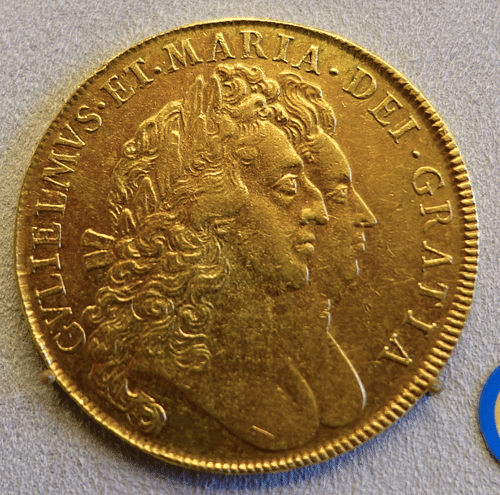
It was a revolution, or rather the beginning of one, in terms of politics. Over the next few years, Parliament ensured it was very much an active player in a new system of government: a constitutional monarchy. This was established by the Bill of Rights of 16 December 1689 and other legislation like the Civil List Act of 1697. Parliament now had the ultimate authority in the key areas of passing laws and raising taxes. No monarch could henceforth maintain their own standing army, only Parliament could declare war, and any new monarch had to swear at their coronation to uphold the Protestant Church. Finally, no Catholic or individual married to a Catholic could ever become king or queen again.
The Jacobites
In 1689, James II made an unsuccessful attempt to return from exile and regain his throne by invading Catholic Ireland, but he was ultimately defeated by William at the battle of Boyne in July 1690. The Jacobites (as supporters of James and the House of Stuart were known) were strong in the Scottish Highlands, but not strong enough to challenge William and Mary's rule there. After James' death in 1701, the Jacobites rallied around Mary's younger brother James, now known as the Old Pretender. A Jacobite rebellion in Scotland was quashed in 1715, as was another in 1745 which sought to put James II's grandson Charles Edward Stuart (aka the Young Pretender or 'Bonnie Prince Charlie', 1720-88) on the throne. As it turned out, the Stuart royal line was about to come to an end anyway.
Reign & Interests
William showed his true aims when he immediately embroiled England in the conflict that became known as the Nine Years' War (1688-1697) against France. The war led to no particular gains for either side. There were suspicions of William because he was not English, and his manner did him no favours. For these reasons, Mary became the popular monarch. After three successive foreign and Catholic queens, the English finally had an English Protestant queen to their liking. In those periods when William returned from campaigning and was back in England, he conducted affairs of state again, and Mary receded into the background. The queen was praised for giving up her regency powers in this way. Mary then confined herself to her three main interests: gardening, collecting and promoting Dutch porcelain, and improving the moral state of her subjects. The latter pursuit involved reducing the levels of prostitution, drunkenness, swearing, and lack of respect for Sundays such as trading on that day. The queen supported such endeavours as the establishment in 1690 of the Society for the Reformation of Manners. Mary ensured that court sermons were made easily available to the public via printed pamphlets. She also took an active role in deciding key appointments in the Anglican Church, for example, John Tillotson as Archbishop of Canterbury. Mary's image of piety worked well with Protestants, but Jacobites and Catholics pointed out her sin of breaking the Fifth Commandment and going against her father's will. Mary's enemies suggested her lack of children was God's punishment.
In 1689 William and Mary purchased Nottingham House in the suburbs of London and transformed it into Kensington Palace. This became a favourite royal residence of the couple. The queen also oversaw new landscape gardens at their country residence, Hampton Court, based on the Dutch model of formal gardens. Another notable achievement of the queen was the founding of the massive Royal Hospital at Greenwich in 1692. This was designed to care for sailors wounded in battles against the French and those lucky enough to reach retirement.
The royal marriage endured, and although they may not have been well suited romantically, they were a good team politically. Mary represented continuity with the Stuart line, Englishness, and piety, while William represented Protestant military power. As the king himself stated: "He was to conquer Enemies, and she was to gain Friends" (Starkey, 404). There did remain the constant problem of an heir for the couple who suffered three stillborn babies.
Successors
Mary contracted smallpox in December 1694, and she died in Kensington Palace on the 28th of that month. The late queen was buried in Westminster Abbey after an impressive ceremony notable for its music composed by Henry Purcell (d. 1695). William was distraught at Mary's death aged just 32, and he refused to marry again. When formally offered the condolences of MPs in Parliament, the king was so overcome with emotion he was unable to reply.
After William III died without an heir in March 1702, Mary's sister Anne became queen, and she then reigned over a united kingdom as Queen of Great Britain and Ireland from 1707 to 1714. Anne was the last of the Stuart monarchs and was succeeded by George I of England (r. 1714-1727) of the House of Hanover.

